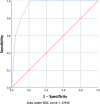Tip-apex distance as a risk factor for cut-out in cephalic double-screw nailing of intertrochanteric femur fractures
- PMID: 38823797
- PMCID: PMC11144064
- DOI: 10.1302/2633-1462.56.BJO-2023-0163.R1
Tip-apex distance as a risk factor for cut-out in cephalic double-screw nailing of intertrochanteric femur fractures
Abstract
Aims: Proximal femur fractures treatment can involve anterograde nailing with a single or double cephalic screw. An undesirable failure for this fixation is screw cut-out. In a single-screw nail, a tip-apex distance (TAD) greater than 25 mm has been associated with an increased risk of cut-out. The aim of the study was to examine the role of TAD as a risk factor in a cephalic double-screw nail.
Methods: A retrospective study was conducted on 112 patients treated for intertrochanteric femur fracture with a double proximal screw nail (Endovis BA2; EBA2) from January to September 2021. The analyzed variables were age, sex, BMI, comorbidities, fracture type, side, time of surgery, quality of reduction, pre-existing therapy with bisphosphonate for osteoporosis, screw placement in two different views, and TAD. The last follow-up was at 12 months. Logistic regression was used to study the potential factors of screw cut-out, and receiver operating characteristic curve to identify the threshold value.
Results: A total of 98 of the 112 patients met the inclusion criteria. Overall, 65 patients were female (66.3%), the mean age was 83.23 years (SD 7.07), and the mean follow-up was 378 days (SD 36). Cut-out was observed in five patients (5.10%). The variables identified by univariate analysis with p < 0.05 were included in the multivariate logistic regression model were screw placement and TAD. The TAD was significant with an odds ratio (OR) 5.03 (p = 0.012) as the screw placement with an OR 4.35 (p = 0.043) in the anteroposterior view, and OR 10.61 (p = 0.037) in the lateral view. The TAD threshold value identified was 29.50 mm.
Conclusion: Our study confirmed the risk factors for cut-out in the double-screw nail are comparable to those in the single screw. We found a TAD value of 29.50 mm to be associated with a risk of cut-out in double-screw nails, when good fracture reduction is granted. This value is higher than the one reported with single-screw nails. Therefore, we suggest the role of TAD should be reconsidered in well-reduced fractures treated with double-screw intramedullary nail.
© 2024 Coviello et al.
Conflict of interest statement
The authors have no conflicts of interest to disclose.
Figures


Similar articles
-
Does Computer-assisted Surgery Improve Lag Screw Placement During Cephalomedullary Nailing of Intertrochanteric Hip Fractures?Clin Orthop Relat Res. 2020 Sep;478(9):2132-2144. doi: 10.1097/CORR.0000000000001306. Clin Orthop Relat Res. 2020. PMID: 32496321 Free PMC article.
-
Predicting cut-out in intertrochanteric fractures fixed with cephalomedullary nails: the role of tip-to-apex distance referenced to calcar (calTAD)--A retrospective analysis of 158 cases.Eur J Orthop Surg Traumatol. 2024 Nov 25;35(1):24. doi: 10.1007/s00590-024-04130-2. Eur J Orthop Surg Traumatol. 2024. PMID: 39585420
-
Correlation between cephalic screw positioning of Standard Gamma 3 Nail for intertrochanteric fractures and cut-out incidence.SICOT J. 2024;10:9. doi: 10.1051/sicotj/2024006. Epub 2024 Feb 26. SICOT J. 2024. PMID: 38415767 Free PMC article.
-
No difference between lag screw and helical blade for cephalomedullary nail cut-out a systematic review and meta-analysis.Eur J Orthop Surg Traumatol. 2022 Dec;32(8):1617-1625. doi: 10.1007/s00590-021-03124-8. Epub 2021 Oct 19. Eur J Orthop Surg Traumatol. 2022. PMID: 34665292
-
Exploring the Efficacy of Computer-Assisted Navigation in Improving Lag Screw Placement and Preventing Cut-Out in Intramedullary Nail Fixation of Femoral Fractures: A Meta-Analysis.Cureus. 2025 Jan 20;17(1):e77724. doi: 10.7759/cureus.77724. eCollection 2025 Jan. Cureus. 2025. PMID: 39981447 Free PMC article. Review.
Cited by
-
Predictive value of tip-apex distance and calcar-referenced tip-apex distance for cut-out in 398 femoral intertrochanteric fractures treated in a private practice with dynamic intramedullary nailing.Front Surg. 2024 Aug 14;11:1438858. doi: 10.3389/fsurg.2024.1438858. eCollection 2024. Front Surg. 2024. PMID: 39205795 Free PMC article.
-
Are Tip-Apex Distance and Surgical Delay Associated with Increased Risk of Complications and Mortality Within the First Two Years After Surgery for Femoral Neck Fractures?J Clin Med. 2025 Jul 15;14(14):4991. doi: 10.3390/jcm14144991. J Clin Med. 2025. PMID: 40725684 Free PMC article.
-
Key factors for increased tip-apex distance when treating intertrochanteric fractures with InterTAN nails.Front Bioeng Biotechnol. 2024 Nov 1;12:1426307. doi: 10.3389/fbioe.2024.1426307. eCollection 2024. Front Bioeng Biotechnol. 2024. PMID: 39553393 Free PMC article.
-
Larger nail-shaft gap as a potential risk factor of femoral head varus in patients treated with proximal femoral nail antirotation fixation: a retrospective, observational, single-center study with corresponding numerical simulation.Quant Imaging Med Surg. 2025 Jul 1;15(7):6032-6043. doi: 10.21037/qims-2024-2988. Epub 2025 Jun 30. Quant Imaging Med Surg. 2025. PMID: 40727332 Free PMC article.
-
Factors Associated with Mortality and Short-Term Patient Outcomes for Hip Fracture Repair in the Elderly Based on Preoperative Anticoagulation Status.Geriatrics (Basel). 2025 Apr 4;10(2):54. doi: 10.3390/geriatrics10020054. Geriatrics (Basel). 2025. PMID: 40277853 Free PMC article.
References
LinkOut - more resources
Full Text Sources
Miscellaneous

